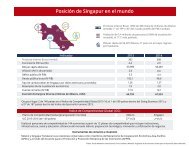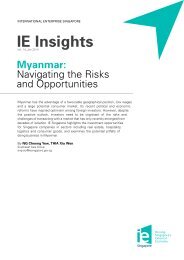basic-guide-to-exporting_Latest_eg_main_086196
basic-guide-to-exporting_Latest_eg_main_086196
basic-guide-to-exporting_Latest_eg_main_086196
Create successful ePaper yourself
Turn your PDF publications into a flip-book with our unique Google optimized e-Paper software.
Textile ProductsThe textile and apparel ROOs are the “yarn-forward” standard, which requires thatthe yarn production and all operations “forward” (fabric production through apparelassembly) occur in the United States and/or the partner country. However, fibers,yarns, and fabrics determined not <strong>to</strong> be available in commercial quantities in a timelymanner may be sourced from outside the countries for use in qualifying textile andapparel products. For example, a fabric that is determined not <strong>to</strong> be commerciallyavailable may come from a third party, be cut and assembled in<strong>to</strong> a garment in thepartner country, and imported <strong>to</strong> the United States duty-free. Other fac<strong>to</strong>rs may need<strong>to</strong> be considered, such as tariff preference levels and saf<strong>eg</strong>uards. To look up ROOsfor textile products, visit otexa.ita.doc.gov and click on the specific FTA countryor r<strong>eg</strong>ion.Fungible Goods and MaterialsFTAs allow treating “fungible goods or materials” as originating where some goodsare FTA eligible but others are not. A fungible good may be considered originatingif the importer, exporter, or producer has either physically s<strong>eg</strong>r<strong>eg</strong>ated (originatingfrom the nonoriginating) the fungible good or material or used any inven<strong>to</strong>rymanagement system <strong>to</strong> s<strong>eg</strong>r<strong>eg</strong>ate what is recognized in the Generally AcceptedAccounting Principles.Indirect MaterialsIndirect materials are considered <strong>to</strong> be originating materials r<strong>eg</strong>ardless of wherethey are produced. An indirect material is defined as a good used in the production,testing, or inspection of a good, but not physically incorporated in<strong>to</strong> the good, or agood used in the <strong>main</strong>tenance of buildings or the operation of equipment associatedwith the production of a good.Accessories, Spare Parts, and ToolsAccessories, spare parts, and <strong>to</strong>ols that are delivered with the goods and thatform part of the goods’ standard accessories, spare parts, or <strong>to</strong>ols, are consideredoriginating if the goods originate and are disr<strong>eg</strong>arded in determining whether all thenon-originating materials undergo tariff change.Certifying Origin of a Product for FTADepending on a particular FTA, the exporter or importer may need <strong>to</strong> document theorigin of the good. Documenting the origin varies, depending on the FTA. In general,the manufacturer, importer, or exporter will certify that a particular good is FTAeligibleeven though it may contain nonoriginating material. The actual certificatesmay be required forms such as U.S.–Israel FTA or NAFTA. (Note: Cus<strong>to</strong>ms authoritiesnow allow the use of an alternative NAFTA form, with prior cus<strong>to</strong>ms approval.)Other FTAs may not require specific certificates. Claiming preference is done bythe importer.210U.S. Commercial Service • A Basic Guide <strong>to</strong> Exporting





